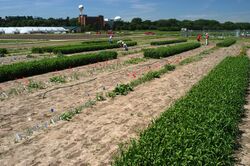Maloof Lab:PGRP
Molecular evolutionary genetics of crop and weed responses to crowding
Funded by the Plant Genome Research Program at NSF
Senior Personnel
- PI: Cynthia Weinig, U. Wyoming
- Co-PI: Julin Maloof, UC Davis
Resources
Genotypic and phenotypic data generated by this project are available for download here
Abstract
Domestication of wild species is characterized by changes in diverse phenotypic traits, including inflorescence architecture, fruit and seed morphology, infructescence shattering, and the timing of developmental events. These changes result from human selection to increase the harvest index and harvest efficiency. Selection for appropriate environmental responses is also important in this regard. For instance, higher planting densities could increase yield in many crop species, but densities are limited by developmental responses to crowding, in which time to flowering decreases and relative allocation to structural organs increases at the cost of agronomically desirable traits such as leaf, root, and fruit production. Regardless of the trait selected in a crop species, agricultural weeds exhibit dramatic and rapid compensatory evolution that increases weed fitness at the cost of crop productivity. Using comparative genetic and genomics tools, the proposed research investigates the genetic basis of phenotypic responses to crowding. The results will contribute significantly to both crop improvement and an understanding of weed evolution that may aid in management.

The research program focuses on crowding responses in Brassica rapa. In addition to the morphologically diverse domesticated varieties of B. rapa, naturalized populations occur in both agricultural fields and disturbed, weedy sites. Thus, this system is appropriate for investigating both the loci targeted during domestication and those underlying adaptation of weed species to agricultural settings. Moreover, the near relative, Arabidopsis thaliana, is a model for the genetic characterization of shade-avoidance responses, facilitating the identification of orthologous loci under selection in B. rapa. The proposed research takes advantage of current genomic tools to investigate the genetic basis of competitive responses in agricultural and natural settings. Specific research goals include 1) identifying quantitative trait loci (QTL) for fitness and traits affecting competitive ability in field settings in B. rapa and A. thaliana, 2) using controlled light environments to identify QTL important for response to specific environmental cues, 3) quantifying evolutionary responses (measured as allele frequency changes) at QTL determining fitness and phenotypic responses to competition in agricultural and disturbed sites, 4) cloning QTL for traits important to competitive ability with the aim of determining both genetic targets for crop improvement and loci underlying evolutionary change in agricultural weeds.
Publications resulting from this grant
-
Weinig C. and Schmitt J. 2004. Environmental effects on the expression of quantitative trait loci and implications for phenotypic evolution. Bioscience 54: 627.
-
Weinig C. 2005. Rapid evolutionary responses to selection in heterogeneous environments among agricultural and non-agricultural weed. International Journal of Plant Sciences 166: 641.
- Nozue K and Maloof JN. Diurnal regulation of plant growth. Plant Cell Environ. 2006 Mar;29(3):396-408. DOI:10.1111/j.1365-3040.2005.01489.x |
- Balasubramanian S, Sureshkumar S, Agrawal M, Michael TP, Wessinger C, Maloof JN, Clark R, Warthmann N, Chory J, and Weigel D. The PHYTOCHROME C photoreceptor gene mediates natural variation in flowering and growth responses of Arabidopsis thaliana. Nat Genet. 2006 Jun;38(6):711-5. DOI:10.1038/ng1818 |
- Weinig C, Johnston J, German ZM, and Demink LM. Local and global costs of adaptive plasticity to density in Arabidopsis thaliana. Am Nat. 2006 Jun;167(6):826-36. DOI:10.1086/503530 |
- Maloof JN. Small but not forgotten. Heredity (Edinb). 2006 Jan;96(1):1-2. DOI:10.1038/sj.hdy.6800708 |
- Weinig C, Brock MT, Dechaine JA, and Welch SM. Resolving the genetic basis of invasiveness and predicting invasions. Genetica. 2007 Feb;129(2):205-16. DOI:10.1007/s10709-006-9015-7 |
- Weinig C, Johnston JA, Willis CG, and Maloof JN. Antagonistic multilevel selection on size and architecture in variable density settings. Evolution. 2007 Jan;61(1):58-67. DOI:10.1111/j.1558-5646.2007.00005.x |
- Nozue K, Covington MF, Duek PD, Lorrain S, Fankhauser C, Harmer SL, and Maloof JN. Rhythmic growth explained by coincidence between internal and external cues. Nature. 2007 Jul 19;448(7151):358-61. DOI:10.1038/nature05946 |
- Dechaine JM, Johnston JA, Brock MT, and Weinig C. Constraints on the evolution of adaptive plasticity: costs of plasticity to density are expressed in segregating progenies. New Phytol. 2007;176(4):874-882. DOI:10.1111/j.1469-8137.2007.02210.x |
- Brock MT, Tiffin P, and Weinig C. Sequence diversity and haplotype associations with phenotypic responses to crowding: GIGANTEA affects fruit set in Arabidopsis thaliana. Mol Ecol. 2007 Jul;16(14):3050-62. DOI:10.1111/j.1365-294X.2007.03298.x |
- Brock MT and Weinig C. Plasticity and environment-specific covariances: an investigation of floral-vegetative and within flower correlations. Evolution. 2007 Dec;61(12):2913-24. DOI:10.1111/j.1558-5646.2007.00240.x |
- Filiault DL, Wessinger CA, Dinneny JR, Lutes J, Borevitz JO, Weigel D, Chory J, and Maloof JN. Amino acid polymorphisms in Arabidopsis phytochrome B cause differential responses to light. Proc Natl Acad Sci U S A. 2008 Feb 26;105(8):3157-62. DOI:10.1073/pnas.0712174105 |
- Jiménez-Gómez JM and Maloof JN. Sequence diversity in three tomato species: SNPs, markers, and molecular evolution. BMC Plant Biol. 2009 Jul 3;9:85. DOI:10.1186/1471-2229-9-85 |
- Stinchcombe JR, Weinig C, Heath KD, Brock MT, and Schmitt J. Polymorphic genes of major effect: consequences for variation, selection and evolution in Arabidopsis thaliana. Genetics. 2009 Jul;182(3):911-22. DOI:10.1534/genetics.108.097030 |
- Dechaine JM, Gardner G, and Weinig C. Phytochromes differentially regulate seed germination responses to light quality and temperature cues during seed maturation. Plant Cell Environ. 2009 Oct;32(10):1297-309. DOI:10.1111/j.1365-3040.2009.01998.x |
-
Dykstra AM, Brock MT, Delph LF, and Weinig C. 2009. Sex-specific trade-offs and responses to foliar shade in the gynodioecious species, Silene vulgaris (Caryophyllaceae). International Journal of Plant Sciences, 170: S75.